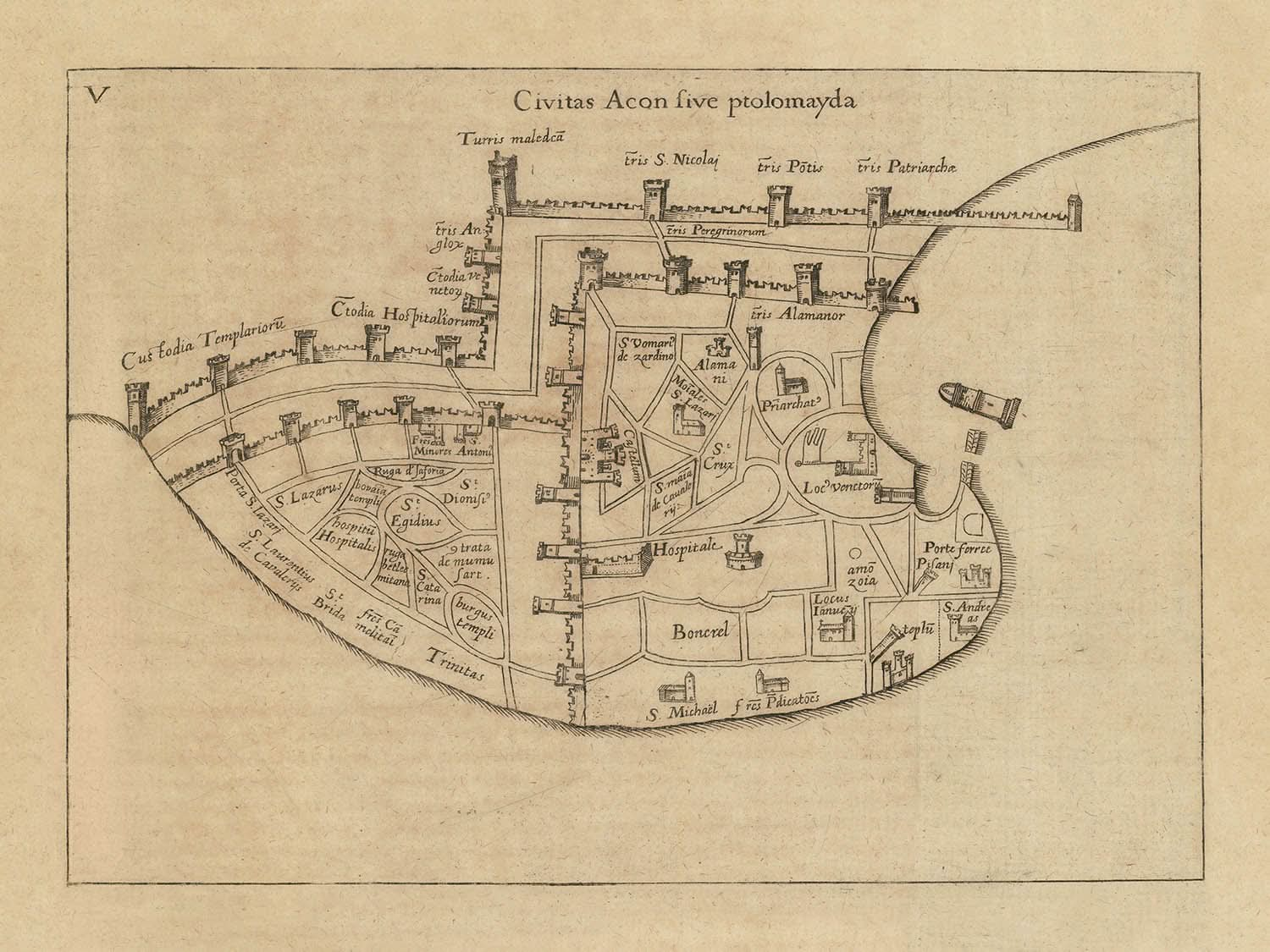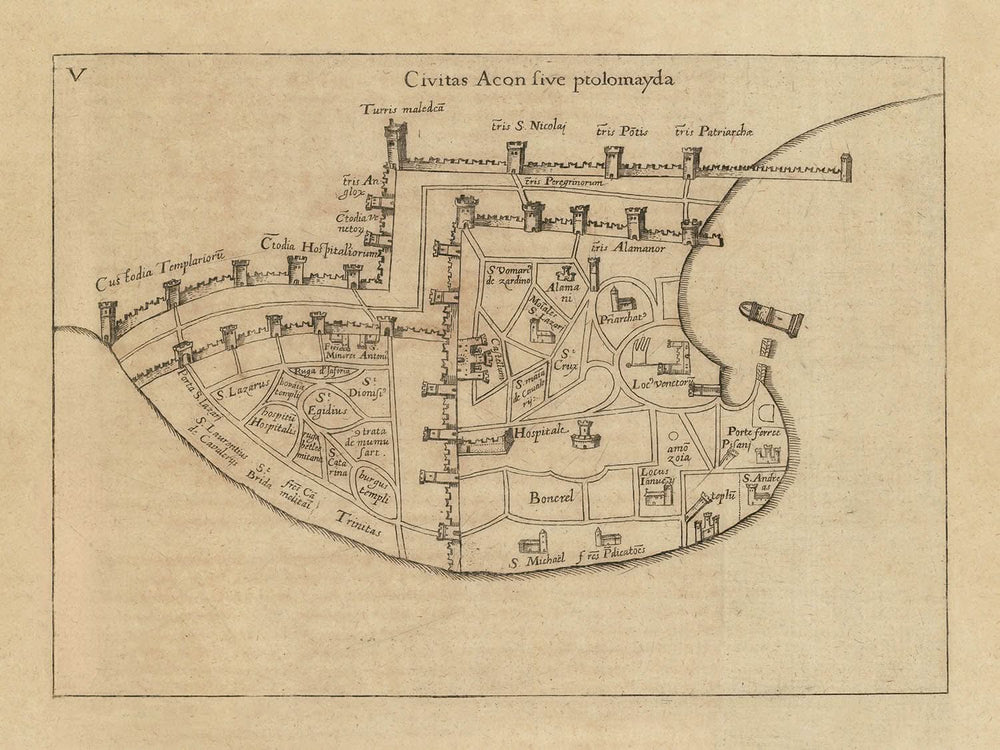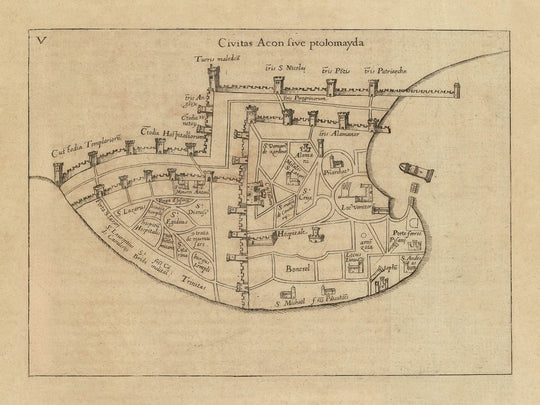- Handmade locally. No import duty or tax
- FREE Delivery by Christmas
- Love it or your money back (90 days)
- Questions? WhatsApp me any time
Own a piece of history
5,000+ 5 star reviews


Step into the captivating world of medieval cartography with the exquisite "Civitas Acon sive Ptolomayda," a masterful representation of Acre during the Crusades. Crafted by the renowned Genoese cartographer Pietro Vesconte in the early 14th century and printed by Johann Bongars in 1611, this map offers a rare glimpse into a pivotal moment in history. Vesconte, celebrated for his pioneering portolan charts, meticulously detailed the city of Acre, showcasing its strategic significance as a European stronghold in the Holy Land. This map stands as a testament to Vesconte's influence on Italian and Catalan mapmaking, capturing the essence of a city that was a focal point of medieval geopolitics.
The map's intricate design reveals the bustling port city of Acre, highlighting its importance as a hub of commerce and conflict. Key features such as the "Custodia Templariorum" and "Custodia Hospitaliorum" mark the presence of the Knights Templar and Knights Hospitaller, respectively, underscoring the city's role as a center of Crusader activity. Each street and structure is meticulously rendered, offering a window into the urban planning and architectural prowess of the time. The detailed depiction of towers, churches, and fortifications reflects the city's fortified nature, essential for its defense against the forces that would eventually reclaim it in 1291.
Historically, this map is invaluable, preserving the layout of Acre before its destruction by Arabic forces. It captures a city on the brink of transformation, a European enclave in the heart of the Levant. The presence of religious sites such as "S. Michael," "S. Andrea," and "S. Maria de Cuna" speaks to the spiritual and cultural significance of Acre during the Crusades. This map not only serves as a geographical guide but also as a narrative of the city's vibrant history, where faith and warfare intersected in the quest for control over the Holy Land.
The artistic style of Vesconte's map is a marvel in itself, combining functionality with aesthetic appeal. The precision with which he delineates the "Portus Pisani" and various towers like "Turris maledicta" and "Turris Patriarche" showcases his mastery of cartographic techniques. His ability to convey the complexity of Acre's urban landscape with clarity and detail is a hallmark of his work, setting a standard for future mapmakers. This map is not just a representation of Acre; it is a piece of art that reflects the intellectual and cultural currents of its time.
Owning this map is akin to holding a piece of history, a tangible connection to the past that invites exploration and discovery. It embodies the spirit of the Crusades, a period marked by ambition, conflict, and cultural exchange. As you delve into the intricacies of "Civitas Acon sive Ptolomayda," you embark on a journey through time, uncovering the stories and secrets of a city that once stood at the crossroads of civilizations. This map is more than a historical document; it is a gateway to understanding the complexities and legacies of the medieval world.
Places on this map
- Custodia Templariorum
- Custodia Hospitaliorum
- Turris maledicta
- Portus Pisani
- S. Michael
- S. Andrea
- S. Dionys
- S. Egidius
- Murum Antonii
- S. Lazarus
- Trinitas
- S. Nicolaï
- Turris Patriarche
- Turris S. Nicolai
- Turris Potiu
- Turris Perigrinorum
- Alma M.
- Locum tenentor
- Bonerel
- S. Maria de Cuna
Notable Features & Landmarks
- Custodia Templariorum: Refers to the Knights Templar’s presence.
- Custodia Hospitaliorum: Indicates the area associated with the Knights Hospitaller.
- Turris maledicta: A notable tower.
- Portus Pisani: The port area.
- S. Michael: A church or religious site.
- S. Andrea: Another religious site.
- S. Dionys: Likely a church or chapel.
- S. Egidius: Another religious building.
- Murum Antonii: Possibly a wall or fortification.
- S. Lazarus: A significant place, possibly a hospital or church.
- Trinitas: Refers to the Trinity, likely a church or religious area.
- S. Nicolaï: Another religious site.
- Turris Patriarche: Patriarch’s Tower.
- Turris S. Nicolai: Tower of St. Nicholas.
- Turris Potiu: Another tower.
- Turris Perigrinorum: Tower of the Pilgrims.
- Alma M.: Possibly a religious or significant building.
- Locum tenentor: A notable location or building.
- Bonerel: Possibly a notable structure or area.
- S. Maria de Cuna: Church or religious site.
Historical and design context
- Earliest Printing: 1611 by Johann Bongars
- Original Mapmaker: Pietro Vesconte, a Genoese cartographer from the early 14th century
- Significance of Vesconte: Known for creating portolan charts and was one of the first mapmakers to sign and date his works.
- Historical Context: Depicts Acre during the Crusades, before its destruction in 1291 by Arabic forces.
- Themes: Shows European control of Acre, emphasizing the presence of the Knights Templar and Knights Hospitaller.
- Design/Style: Detailed depiction of city structures, roads, and significant buildings, typical of Vesconte’s detailed style.
- Historical Significance: Preserves the layout of Acre as it was before its destruction, offering insights into medieval urban planning and military architecture.
Please double check the images to make sure that a specific town or place is shown on this map. You can also get in touch and ask us to check the map for you.
This map looks great at every size, but I always recommend going for a larger size if you have space. That way you can easily make out all of the details.
This map looks amazing at sizes all the way up to 40in (100cm). If you are looking for a larger map, please get in touch.
The model in the listing images is holding the 18x24in (45x60cm) version of this map.
The fifth listing image shows an example of my map personalisation service.
If you’re looking for something slightly different, check out my collection of the best old maps to see if something else catches your eye.
Please contact me to check if a certain location, landmark or feature is shown on this map.
This would make a wonderful birthday, Christmas, Father's Day, work leaving, anniversary or housewarming gift for someone from the areas covered by this map.
This map is available as a giclée print on acid free archival matte paper, or you can buy it framed. The frame is a nice, simple black frame that suits most aesthetics. Please get in touch if you'd like a different frame colour or material. My frames are glazed with super-clear museum-grade acrylic (perspex/acrylite), which is significantly less reflective than glass, safer, and will always arrive in perfect condition.
This map is also available as a float framed canvas, sometimes known as a shadow gap framed canvas or canvas floater. The map is printed on artist's cotton canvas and then stretched over a handmade box frame. We then "float" the canvas inside a wooden frame, which is available in a range of colours (black, dark brown, oak, antique gold and white). This is a wonderful way to present a map without glazing in front. See some examples of float framed canvas maps and explore the differences between my different finishes.
For something truly unique, this map is also available in "Unique 3D", our trademarked process that dramatically transforms the map so that it has a wonderful sense of depth. We combine the original map with detailed topography and elevation data, so that mountains and the terrain really "pop". For more info and examples of 3D maps, check my Unique 3D page.
For most orders, delivery time is about 3 working days. Personalised and customised products take longer, as I have to do the personalisation and send it to you for approval, which usually takes 1 or 2 days.
Please note that very large framed orders usually take longer to make and deliver.
If you need your order to arrive by a certain date, please contact me before you order so that we can find the best way of making sure you get your order in time.
I print and frame maps and artwork in 23 countries around the world. This means your order will be made locally, which cuts down on delivery time and ensures that it won't be damaged during delivery. You'll never pay customs or import duty, and we'll put less CO2 into the air.
All of my maps and art prints are well packaged and sent in a rugged tube if unframed, or surrounded by foam if framed.
I try to send out all orders within 1 or 2 days of receiving your order, though some products (like face masks, mugs and tote bags) can take longer to make.
If you select Express Delivery at checkout your order we will prioritise your order and send it out by 1-day courier (Fedex, DHL, UPS, Parcelforce).
Next Day delivery is also available in some countries (US, UK, Singapore, UAE) but please try to order early in the day so that we can get it sent out on time.
My standard frame is a gallery style black ash hardwood frame. It is simple and quite modern looking. My standard frame is around 20mm (0.8in) wide.
I use super-clear acrylic (perspex/acrylite) for the frame glass. It's lighter and safer than glass - and it looks better, as the reflectivity is lower.
Six standard frame colours are available for free (black, dark brown, dark grey, oak, white and antique gold). Custom framing and mounting/matting is available if you're looking for something else.
Most maps, art and illustrations are also available as a framed canvas. We use matte (not shiny) cotton canvas, stretch it over a sustainably sourced box wood frame, and then 'float' the piece within a wood frame. The end result is quite beautiful, and there's no glazing to get in the way.
All frames are provided "ready to hang", with either a string or brackets on the back. Very large frames will have heavy duty hanging plates and/or a mounting baton. If you have any questions, please get in touch.
See some examples of my framed maps and framed canvas maps.
Alternatively, I can also supply old maps and artwork on canvas, foam board, cotton rag and other materials.
If you want to frame your map or artwork yourself, please read my size guide first.
My maps are extremely high quality reproductions of original maps.
I source original, rare maps from libraries, auction houses and private collections around the world, restore them at my London workshop, and then use specialist giclée inks and printers to create beautiful maps that look even better than the original.
My maps are printed on acid-free archival matte (not glossy) paper that feels very high quality and almost like card. In technical terms the paper weight/thickness is 10mil/200gsm. It's perfect for framing.
I print with Epson ultrachrome giclée UV fade resistant pigment inks - some of the best inks you can find.
I can also make maps on canvas, cotton rag and other exotic materials.
Learn more about The Unique Maps Co.
Map personalisation
If you're looking for the perfect anniversary or housewarming gift, I can personalise your map to make it truly unique. For example, I can add a short message, or highlight an important location, or add your family's coat of arms.
The options are almost infinite. Please see my map personalisation page for some wonderful examples of what's possible.
To order a personalised map, select "personalise your map" before adding it to your basket.
Get in touch if you're looking for more complex customisations and personalisations.
Map ageing
I have been asked hundreds of times over the years by customers if they could buy a map that looks even older.
Well, now you can, by selecting Aged before you add a map to your basket.
All the product photos you see on this page show the map in its Original form. This is what the map looks like today.
If you select Aged, I will age your map by hand, using a special and unique process developed through years of studying old maps, talking to researchers to understand the chemistry of aging paper, and of course... lots of practice!
If you're unsure, stick to the Original colour of the map. If you want something a bit darker and older looking, go for Aged.
If you are not happy with your order for any reason, contact me and I'll get it fixed ASAP, free of charge. Please see my returns and refund policy for more information.
I am very confident you will like your restored map or art print. I have been doing this since 1984. I'm a 5-star Etsy seller. I have sold tens of thousands of maps and art prints and have over 5,000 real 5-star reviews. My work has been featured in interior design magazines, on the BBC, and on the walls of dozens of 5-star hotels.
I use a unique process to restore maps and artwork that is massively time consuming and labour intensive. Hunting down the original maps and illustrations can take months. I use state of the art and eye-wateringly expensive technology to scan and restore them. As a result, I guarantee my maps and art prints are a cut above the rest. I stand by my products and will always make sure you're 100% happy with what you receive.
Almost all of my maps and art prints look amazing at large sizes (200cm, 6.5ft+) and I can frame and deliver them to you as well, via special oversized courier. Contact me to discuss your specific needs.
Or try searching for something!
















































